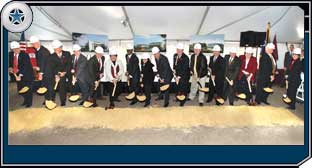Texas A&M Health Science Center
Texas A&M Health Science Center's new campus blends function and design
 |
|
The Medical Research and Education Building (left) and the Health Professions Education Building (right) are the first two buildings scheduled for completion, in 2011 and 2010, respectively.
|
Given the chance to create a new campus along the tree-lined hills northwest of Bryan, Texas, leaders at the Texas A&M Health Science Center resolved from the outset that they would not only usher in a much-needed facility, but also make a statement about the finest and most fundamental principles of medical care.
"We want to build a campus unlike other campuses," said Nancy W. Dickey, M.D., president of the Texas A&M Health Science Center and vice chancellor for health affairs for The Texas A&M University System. "We want it to be academic and peaceful. We want the buildings to be designed around functions-research, teaching-and not around disciplines. We want it to be a place that is welcoming and valuable to our students as well as to the public; one that supports and promotes life-long learning and an interdisciplinary approach to health care."
Everything about the new campus envisions the present through the eyes of the future. The 200-acre tract of land, donated by the city of Bryan, is being developed in stages to accommodate expansion for decades to come. Once in full operation, the new campus will allow the Texas A&M Health Science Center to begin consolidation of its administrative and academic programs, which currently are dispersed throughout Bryan and College Station. The first two buildings scheduled for completion, the Health Professions Education Building and the Medical Research and Education Building, are to open in 2010 and 2011, respectively.

|
|
Legislators, city officials, community leaders and Texas A&M University System administrators join shovels for the ceremonial groundbreaking at the site of the new Texas A&M Health Science Center campus in Bryan.
|
The four-story, 128,000-square-foot Health Professions Education Building will feature a state-of-the art simulation center with computer-programmed manikins in simulated clinical and hospital environments. Also planned are classrooms, seminar rooms, an information technology hub, and a Teaching and Learning Resource Center. The entire $68 million project will be financed through the Permanent University Fund (PUF).
The four-story, 127,500-square-foot Medical Research and Education Building will house seminar rooms, a scientific display area, vivarium, laboratories, imaging lab and faculty offices. Of the $60 million total cost, $15 million will come from PUF debt proceeds. The remaining cost will be paid by tuition revenue bonds, and indirect cost recovery and interest income.
The Texas A&M Health Science Center provides the state with health education, outreach and research. Its seven colleges located in communities throughout Texas are the Baylor College of Dentistry, the College of Medicine, the College of Nursing, the Graduate School of Biomedical Sciences, the Institute of Biosciences and Technology, the Irma Lerma Rangel College of Pharmacy and the School of Rural Public Health.